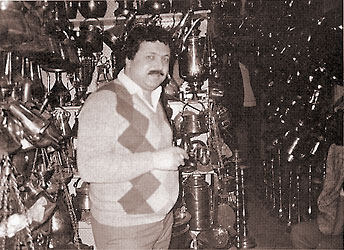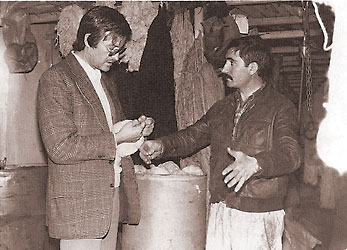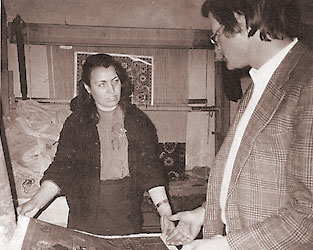
The history of the Bieberproject
These days, in a climate of international market uncertainty, the manufacture of carpets can be commercially successful only if the most stringent requirements can be satisfied by intensive marketing. Such a process is very capital-intensive and there is no guarantee that a product which is highly praised today does not become a white elephant tomorrow.
The Kavacik Project in Istanbul has ignored the problems of the present-day carpet trade and also the various trends and fashions. The carpet models used were the works of unknown Anatolian master weavers which can be seen in the famous museums in Istanbul and found in the carpet literature. It was the aim of the Project right from the start to produce high quality village and workshop carpets. The materials and techniques are those which were used in the weaving areas before the introduction of synthetic dyes. The main priority is the individual character of every single carpet - not mass production. The leading personalities involved with the Project are Yorgo Mihailidis (fig. 1), who looked after the finances, and Mehmet Abuşka (fig. 2 on the right), who was so inspired by the idea of dyeing with natural vegetable pigments that he left his village on the Large Ararat in order to train for a new craft in Istanbul. In addition to these two enthusiastic men, the Project is carried by a large number of Anatolian girls and women who live in the Gecekondus, estates which went up overnight in the city of seven million people. They form the basis of a carpet workshop which was established four years ago in Kavacik in the Asian part of Istanbul. Even the most starryeyed optimists warned against the setting up of a manufacture in a region which had no carpet tradition. But all warnings were forgotten when we met the carpet master Susan Altin (fig. 3 on the left) from Malatya. Her life story is representative of the many families who today live in the Gecekondus of Istanbul. Lack of any infra-structure caused her family fifteen years ago to move from Malatya to Istanbul. The culmination of their hopes and dreams was a Gecekondu at the outskirts of the metropolis. In these Gecekondus the girls and women follow a much more conservative life style than in the Anatolian villages and are much more closely tied to their families. This change of lifestyle restricts the scope of the women. Whereas the men have a more or less regular job - although 75 per cent are unemployed - the women are limited to housework and occasional work that they can do from home, which is in no way connected with their former activities, i.e., wool production and fabrication and carpet weaving.
The leading personalities involved with the Project are Yorgo Mihailidis (fig. 1), who looked after the finances, and Mehmet Abuşka (fig. 2 on the right), who was so inspired by the idea of dyeing with natural vegetable pigments that he left his village on the Large Ararat in order to train for a new craft in Istanbul. In addition to these two enthusiastic men, the Project is carried by a large number of Anatolian girls and women who live in the Gecekondus, estates which went up overnight in the city of seven million people. They form the basis of a carpet workshop which was established four years ago in Kavacik in the Asian part of Istanbul. Even the most starryeyed optimists warned against the setting up of a manufacture in a region which had no carpet tradition. But all warnings were forgotten when we met the carpet master Susan Altin (fig. 3 on the left) from Malatya. Her life story is representative of the many families who today live in the Gecekondus of Istanbul. Lack of any infra-structure caused her family fifteen years ago to move from Malatya to Istanbul. The culmination of their hopes and dreams was a Gecekondu at the outskirts of the metropolis. In these Gecekondus the girls and women follow a much more conservative life style than in the Anatolian villages and are much more closely tied to their families. This change of lifestyle restricts the scope of the women. Whereas the men have a more or less regular job - although 75 per cent are unemployed - the women are limited to housework and occasional work that they can do from home, which is in no way connected with their former activities, i.e., wool production and fabrication and carpet weaving.
 Thus an enormous potential of skill and experience for the manufacture of carpets is wasted. On the other hand,when we showed Susan naturally dyed wools and the carpet models, she at once agreed to weave the first carpet for us. Anybody who visits the workshop in Kavacik today is surprised by the family atmosphere and the close relationship between the weavers and their 'master'. There are seventeen looms where almost forty women and girls aged between fifteen and twenty-five work from sketches and carpet fragments. Every drawing is accompanied by a precise structural analysis. Photographs of design details and carpet structure help the weavers with their work.
Thus an enormous potential of skill and experience for the manufacture of carpets is wasted. On the other hand,when we showed Susan naturally dyed wools and the carpet models, she at once agreed to weave the first carpet for us. Anybody who visits the workshop in Kavacik today is surprised by the family atmosphere and the close relationship between the weavers and their 'master'. There are seventeen looms where almost forty women and girls aged between fifteen and twenty-five work from sketches and carpet fragments. Every drawing is accompanied by a precise structural analysis. Photographs of design details and carpet structure help the weavers with their work.
The master is responsible for the choice of wool for warp, weft and pile. For the first piece, the dyed wool is provided. For the second and third piece, master and weaver can make their own decision within the given colour scheme. The weavers are capable of working from memory, even after having woven a complicated design composition only three times.
In order to encourage the workers and maintain their morale, they are well paid and enjoy a number of social benefits. The healthy working climate is evident by the fact that there is little fluctuation among the work force and that the weavers are always ready to discuss new carpet models when they arrive at the workshop. The individual interpretation of the patterns during weaving is highly admirable. It was particularly noticeable in the two Usak carpets which were made specially for the Vienna conference.
 It becomes more and more evident that a weaver makes a carpet for herself - eyeh if she never sees it again. Since the inception of the Kavacik Project, a hard core, of twenty-five talented workers was trained who, in turn, pass their skill to newly engaged girls and women. At present the Project is suffering from lack of space, problem which can only be solved by opening a second workshop. The results of years of field research in Anatolia supplied the basis for the establishment of the Kavacik Project. Three aspects are of fundamental importance for the manufacture of carpets:
It becomes more and more evident that a weaver makes a carpet for herself - eyeh if she never sees it again. Since the inception of the Kavacik Project, a hard core, of twenty-five talented workers was trained who, in turn, pass their skill to newly engaged girls and women. At present the Project is suffering from lack of space, problem which can only be solved by opening a second workshop. The results of years of field research in Anatolia supplied the basis for the establishment of the Kavacik Project. Three aspects are of fundamental importance for the manufacture of carpets: